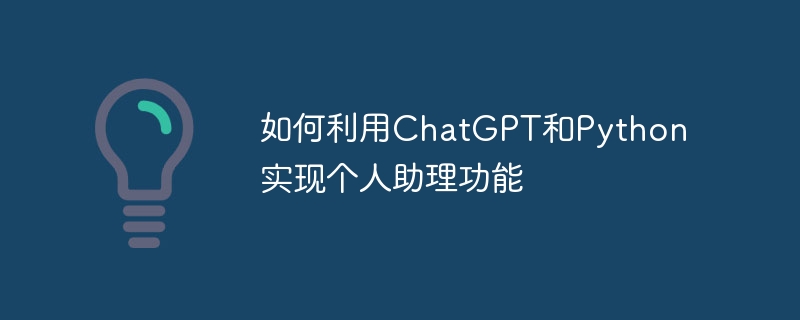Home >Backend Development >Python Tutorial >How to use ChatGPT and Python to implement personal assistant functions
How to use ChatGPT and Python to implement personal assistant functions
- WBOYWBOYWBOYWBOYWBOYWBOYWBOYWBOYWBOYWBOYWBOYWBOYWBOriginal
- 2023-10-24 10:21:11848browse

How to use ChatGPT and Python to implement personal assistant functions
Overview:
In modern society, as the pace of people’s lives accelerates, the needs of personal assistants have also changed. become increasingly important. ChatGPT is a deep learning-based conversation generation model that can help us implement the functions of a personal assistant. In this article, we'll show you how to build a simple personal assistant using ChatGPT and Python, and provide some concrete code examples.
Step 1: Install the required libraries
First, we need to install the required libraries. We need to use the transformers library to load the ChatGPT model and the tkinter library to create a simple user interface. You can use the following command to install:
pip install transformers pip install tk
Step 2: Load the ChatGPT model
Next, we need to load the ChatGPT model. ChatGPT models can be loaded using custom functions provided by the transformers library. The following is a sample code to load the ChatGPT model:
from transformers import pipeline
chat_model = pipeline("conversational", model="gpt2")This code will use the transformers library to load the ChatGPT model and assign it to the chat_model variable.
Step Three: Create User Interface
We use the tkinter library to create a simple user interface so that users can interact with the personal assistant. Here is a sample code:
from tkinter import *
def send_message():
user_message = user_entry.get()
user_entry.delete(0, END)
chat_history.config(state=NORMAL)
chat_history.insert(END, "You: " + user_message + "
")
chat_history.config(state=DISABLED)
response = chat_model(user_message)[0]["generated_text"]
chat_history.config(state=NORMAL)
chat_history.insert(END, "Bot: " + response + "
")
chat_history.config(state=DISABLED)
root = Tk()
root.title("Personal Assistant")
scrollbar = Scrollbar(root)
scrollbar.pack(side=RIGHT, fill=Y)
chat_history = Text(root, yscrollcommand=scrollbar.set)
chat_history.pack()
user_entry = Entry(root)
user_entry.pack()
send_button = Button(root, text="Send", command=send_message)
send_button.pack()
root.mainloop()This code creates a window that contains a text box that displays the conversation history, a text box for user input, and a send button. When the user clicks the send button, the send_message function is called and sends the message entered by the user to the ChatGPT model, and displays the reply generated by the model in the conversation history.
Step 4: Run the Personal Assistant
To run the Personal Assistant, just run the above code. Type your message in the window and click the Send button, and you'll see the replies generated by the ChatGPT model appear in the conversation history.
Summary:
This article describes how to use ChatGPT and Python to build a simple personal assistant. We learned how to load a ChatGPT model and create a user interface so users can interact with a personal assistant. Through proper design and improvement, we can further expand the functionality of this personal assistant, enabling it to perform more complex tasks and provide more assistance.
The above is a simple implementation of a personal assistant based on ChatGPT and Python. I hope it can be helpful to you.
The above is the detailed content of How to use ChatGPT and Python to implement personal assistant functions. For more information, please follow other related articles on the PHP Chinese website!

